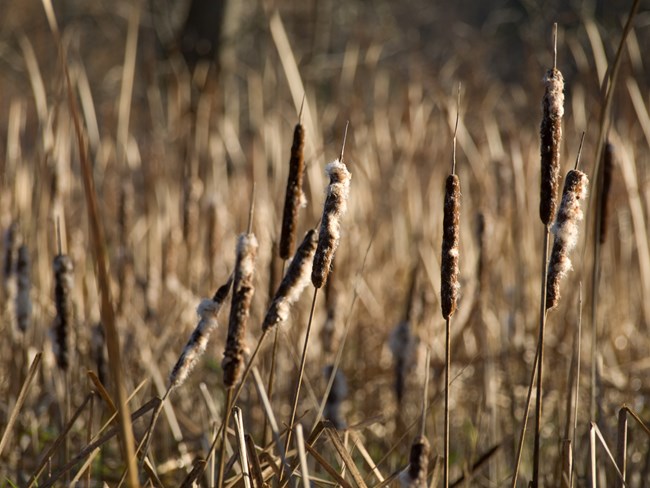
NPS / Stian Rice Narrow-Leaved Cattail and Hybrid Cattail, Typha angustifolia and T. x glaucaNarrow-leaved and hybrid cattails are erect, rhizomatous perennials that grow up to 10 feet. These invasives grow in marshes, wet meadows, fens, estuaries, bogs, and ditches and along lakeshores. They can dominate disturbed wetlands and tolerate salty environments. Broad-leaved, narrow-leaved, and hybrid cattails frequently occur together. IdentificationThe cigar-shaped fruits are 2 to 6 inches long and contain soft, downy seeds. Leaves are 2 to 5 feet long, very narrow, and flat. The narrow-leaved and hybrid cattails have leaves that are 1/4 to 3/4 inches across, while the native cattail's leaves are wider at 1/2 to 1 inch. OriginNarrow-leaved cattail is not native to Northeast Ohio, but may be native to North America. This plant acts as an invasive in disturbed environments. Narrow-leaved cattail hybridizes with the native broad-leaved cattail (T. latifolia) to produce the invasive T. x glauca. How It SpreadsCattails reproduce by seed and root-like rhizomes. Their primary means of colonizing new areas is by seed. Once established, colonies spread by the growth of roots. Seeds are wind pollinated and require moisture but not oxygen for germination. Control MethodsDig rhizomes and remove from site as new plants may form from the damaged roots. From June through July, herbicides can be used successfully through foliar application. Re-treatments are usually necessary due to the extensive root systems of cattails. |
Last updated: March 3, 2022
